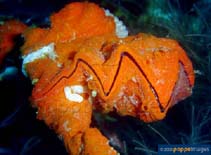Dendostrea folium (Linnaeus, 1758)
Leaf oysterWarning: DOMDocument::load(): SSL operation failed with code 1. OpenSSL Error messages: error:140770FC:SSL routines:SSL23_GET_SERVER_HELLO:unknown protocol in C:\Apache24\htdocs\includes\SpeciesSummary.lib.php on line 1236
Warning: DOMDocument::load(): Failed to enable crypto in C:\Apache24\htdocs\includes\SpeciesSummary.lib.php on line 1236
Warning: DOMDocument::load(https://sealifebase.nrm.se/webservice/AquaMaps/getAMap.php?genus=Dendostrea&species=folium): failed to open stream: operation failed in C:\Apache24\htdocs\includes\SpeciesSummary.lib.php on line 1236
Warning: DOMDocument::load(): I/O warning : failed to load external entity "https://sealifebase.nrm.se/webservice/AquaMaps/getAMap.php?genus=Dendostrea&species=folium" in C:\Apache24\htdocs\includes\SpeciesSummary.lib.php on line 1236
Classification / Names Common names | Synonyms | CoL | ITIS | WoRMS
| Ostreida | Ostreidae
Environment: milieu / climate zone / depth range / distribution range Ökologie
; tiefenbereich 0 - 28 m (Ref. 75840). Tropical
Verbreitung Länder | FAO Gebiete | Ecosystems | Vorkommen | Einführungen
Indo-West Pacific: from East Africa, to Melanesia; north to Japan and south to Queensland.
Length at first maturity / Size / Gewicht / Alter
Maturity: Lm ? range ? - ? cm Max length : 10.0 cm SHH Männchen/unbestimmt; (Ref. 348); common length : 6.0 cm SHH Männchen/unbestimmt; (Ref. 348)
On rocks or sea whip stems. Common in mangrove areas (Ref. 348). Also found in mud, rubble, and shell hash (Ref. 75840). Shallow sublittoral, on boulders and corals (Ref. 127083).
Life cycle and mating behavior Geschlechtsreife | Fortpflanzung | Ablaichen | Eier | Fecundity | Larven
Members of the class Bivalvia are mostly gonochoric, some are protandric hermaphrodites. Life cycle: Embryos develop into free-swimming trocophore larvae, succeeded by the bivalve veliger, resembling a miniature clam.
Hauptreferenz
Referenzen | Koordinator | Partner
Poutiers, J.M. 1998. (Ref. 348)
IUCN Rote Liste Status (Ref. 130435)
CITES Status (Ref. 108899)
Not Evaluated
CMS (Ref. 116361)
Not Evaluated
Bedrohung für Menschen
Harmless
Nutzung durch Menschen
| FishSource |
Tools
Mehr Information
Alter/Größe
Wachstum
Länge-Gewicht
Länge-Länge
Morphologie
Larven
Dichte
Wachstum
Länge-Gewicht
Länge-Länge
Morphologie
Larven
Dichte
Internet Quellen
BHL | BOLD Systems | CISTI | DiscoverLife | FAO(Publication : search) | Fishipedia | GenBank (Genom, nucleotide) | GloBI | Gomexsi | Google Books | Google Scholar | Google | PubMed | Tree of Life | Wikipedia (Gehe zu, Suchen) | Zoological Record
Estimates based on models
Preferred temperature
(Ref. 115969): 23.9 - 29.2, mean 28.3 (based on 2997 cells).
Preiskategorie
(Ref. 80766):
Unknown.



